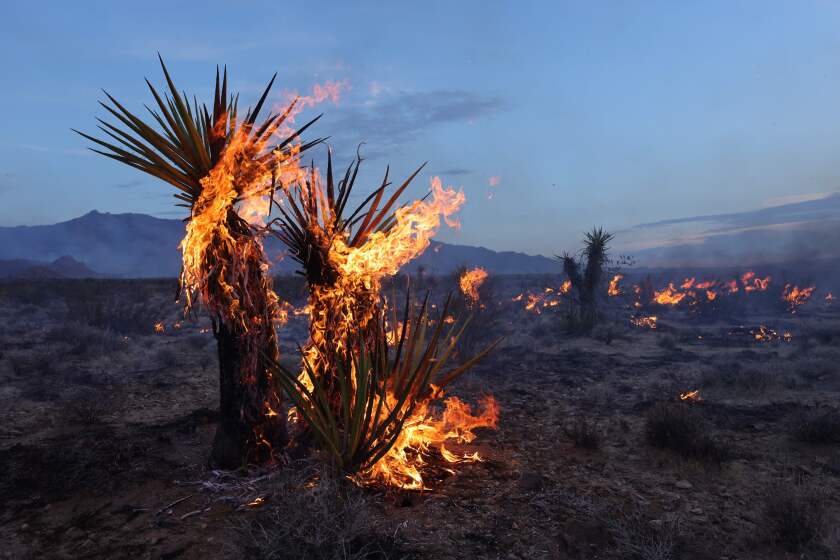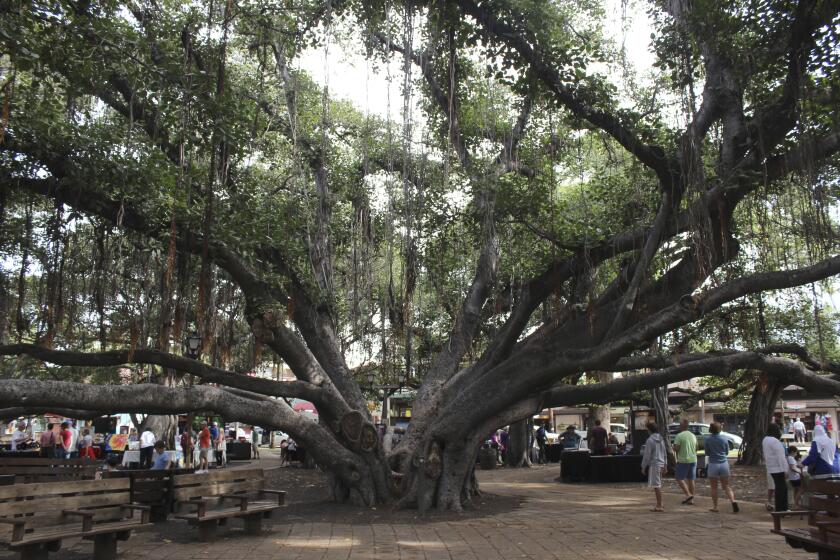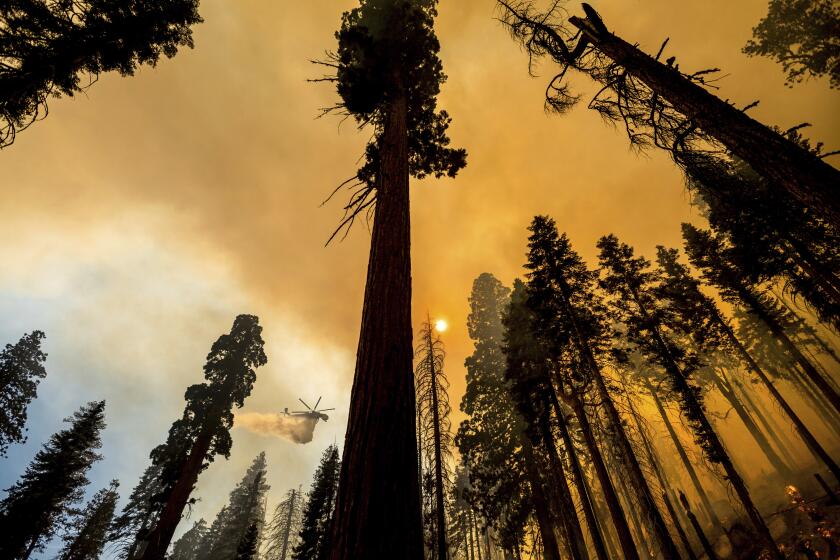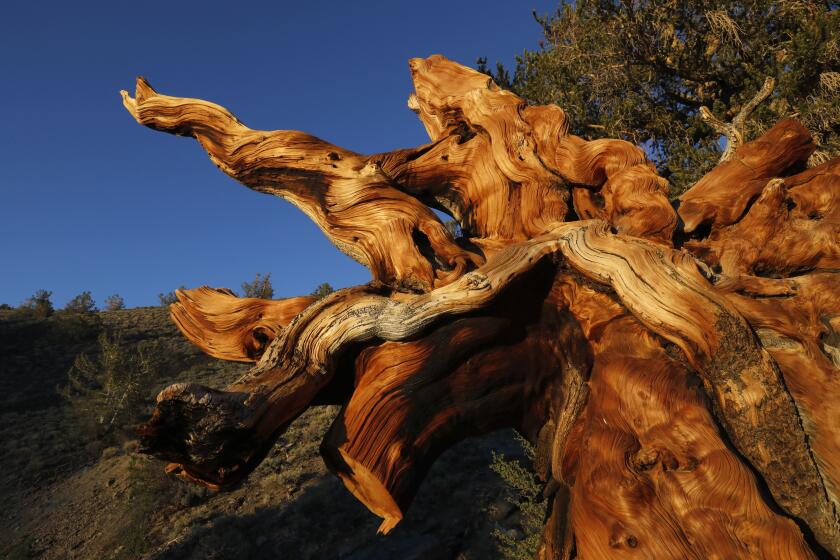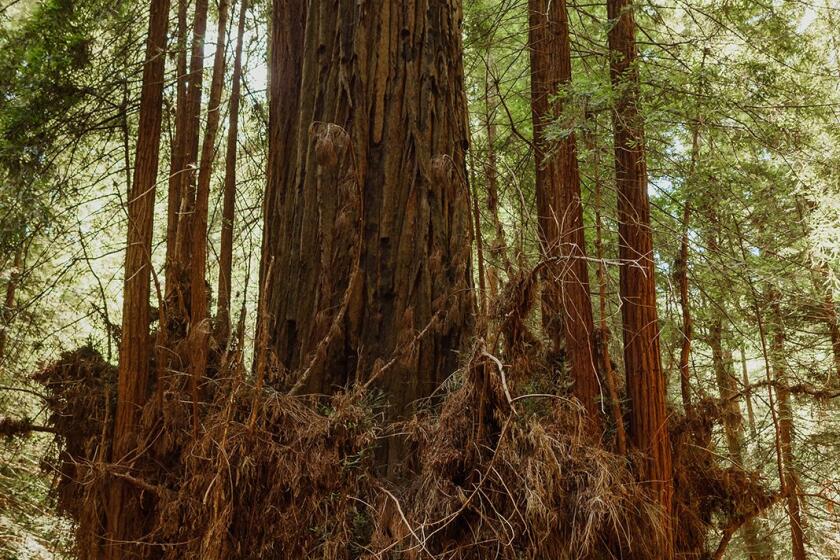Millions of California trees are dying; Joshua trees are just the latest victims
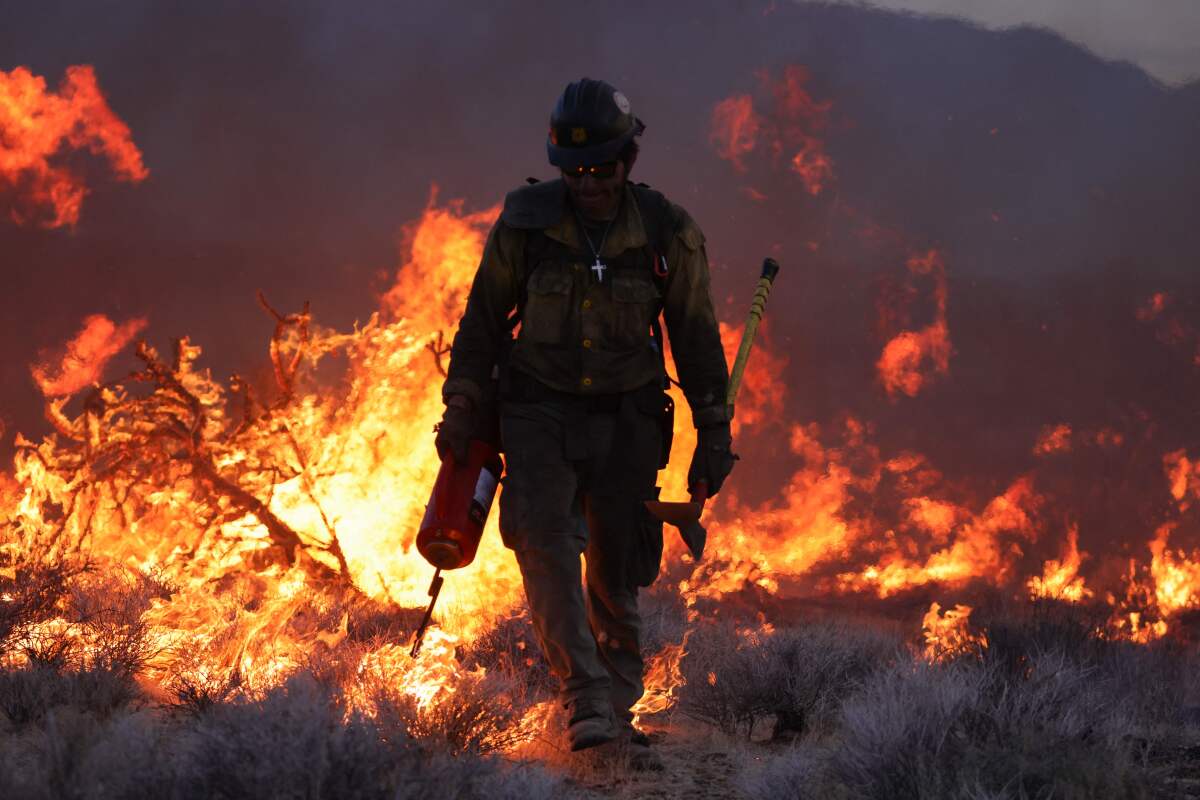
- Share via
Californians watched in dismay this month as the York fire seared through Mojave National Preserve, igniting a delicate desert landscape that may never fully recover.
The fire chewed through stands of beloved Joshua trees, torching their tops and potentially incinerating their roots. Park officials fear that millions may have been burned in the fire, though the precise number of those killed will be hard to discern from the piles of ash that remain.
But researchers say Joshua trees are just the latest species to suffer unprecedented losses amid a climate that is growing warmer and drier.
From towering sequoias to ancient bristlecone pines, millions of California trees are succumbing to worsening wildfires, severe drought, extreme heat, disease and other stressors that have been intensified by global warming. The losses, they say, will only accelerate.
“We’ve long known that the trends to anticipate in the 21st century are extended droughts and more active fire regimes, and these types of disturbances are having profound effects on forests statewide,” said Ryan Tompkins, forest and natural resources advisor at the University of California Cooperative Extension.
About one-third of the state is covered by forested ecosystems, and they have always experienced some form of drought, fire and tree death, he said. “But the problem is we’re seeing tree mortality rates that are far beyond those endemic levels. There’s no doubt that climate is exacerbating what we’re seeing.”
Joshua trees are already struggling to reproduce in a warming climate. Replacing those lost in the York fire may be all but impossible, experts fear.
Indeed, an estimated 36.3 million dead trees were counted across California in 2022 — a notable increase from the 9.5 million dead trees counted the year before, according to a report from the U.S. Forest Service.
The dramatic die-offs were largely attributed to drought, disease and insects such as bark beetles, which prey on weakened trees. Douglas firs showed the biggest mortality rate increase, 1,650%, followed by white and red firs.

Pine trees are also growing more vulnerable to traditional threats.
Since 2013, drought and bark beetles have killed thousands of bristlecone pines — considered the oldest trees on Earth — at Telescope Peak in Death Valley National Park. Some of the trees that died were as old as 1,612 years, according to one recent study.
Though the bristlecone is “revered for its extreme longevity and has been considered an icon of stability during periods of change,” warming temperatures and extreme dryness are stressing the trees and leading to death, the study said. What’s more, the beetles that kill them are flourishing amid the changing conditions at the high elevations where the trees typically grow.
The massive banyan tree in downtown Lahaina, a town on Maui that was decimated by deadly wildfire, is still standing. Officials aren’t sure if the landmark can recover from the flames.
Ponderosa pines are also suffering from bark beetles and heat-related stress, said Avery Hill, a postdoctoral researcher at the California Academy of Sciences. He noted that for every 1.8 degrees of additional global warming, up to 40% more trees could die from beetle infestations.
“The climate has been changing, but it’s the rate that matters,” Hill said. “And why it’s the rate that matters is because the rate at which individual organisms and species and ecosystems can respond to climate change seems to be a lot slower than the actual rate of climate change today.”
Hill recently co-authored a study that found about 20% of all conifer trees in California’s Sierra Nevada are no longer compatible with their surrounding climate, a term he dubbed “zombie forests.” These trees are losing their ability to reproduce and probably will not be able to replace themselves in the future, he said.
“Every species has a set of environmental conditions that it’s best adapted to and can reproduce in and thrive in, and these components are biological but also related to climate,” Hill said. “Climate is one of those environmental variables that, like a house of cards, a lot of other things are built upon.”
Loss could have grave consequences for California wildlife, including protected species such as spotted owls and Pacific fishers.
His study came on the heels of another one published last November, which found that nearly a third of southern Sierra forests were killed by wildfires, drought and pestilence over the last decade.
Such dizzying losses were only amplified by the York fire, which produced harrowing images of Joshua trees alight as it burned through the Mojave.

“The reality is that Joshua trees are already in a state of decline because of global warming and increasing frequency of drought,” ecologist James Cornett told The Times as the fire raged. “And then on top of that, you throw on a fire like the York fire, and these trees are not likely to recover in our lifetime.”
The potential loss of Joshua trees is becoming an all-too-familiar refrain for Californians. Between 1985 and 2021, tree cover in California declined by 6.7% due largely to drought and fire, while Southern California saw the greatest loss of tree cover, research has found.
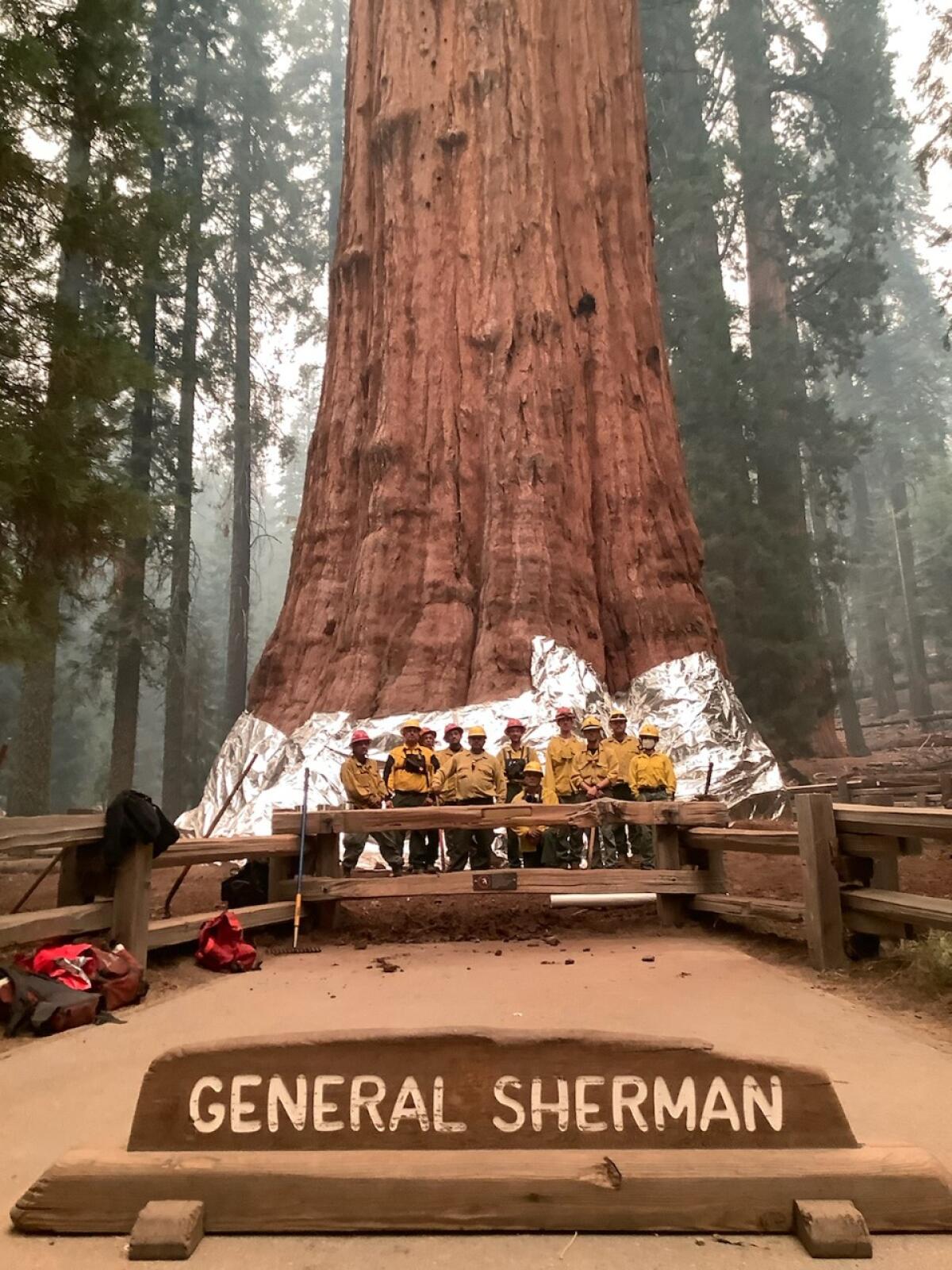
“California’s climate is warming and drying fast enough that it’s sort of lifting the lid off of where fire can go,” said Jon Wang, an associate professor at the School of Biological Sciences at the University of Utah, who led the study.
That includes forests that are home to California’s towering, ancient sequoia trees, which are also under siege as increasingly large, fast and frequent wildfires defeat their time-tested defenses.
Though the trees evolved with fire — and in fact depend on it for reproduction — Wang and other experts said they are not well equipped for the frequency and intensity of today’s raging blazes.
Many Californians will remember the KNP Complex fire of 2021, which tore through Sequoia and Kings Canyon National Parks and produced an indelible image of the giant General Sherman tree wrapped in aluminum foil to protect it from the flames.

The fire, along with another blaze known as the Windy fire, scorched 27 giant sequoia groves and killed as many as 2,380 trees, according to the National Park Service.
The loss compounded that of the Castle fire, which burned in Sequoia National Park a year earlier and killed an estimated 10% of the world’s giant sequoia population, stunning even experts as flames incinerated the trees’ armored bark.
Extreme drought and bark beetles now threaten California’s Ancient Bristlecone Pine Forest, home to Methuselah, a 4,853-year-old bristlecone pine.
But climate change isn’t the only driver of tree death in California, said Tompkins, of the UC Cooperative Extension. The density of forests is also making them more prone to burn, as decades of forest management policies allowed for a buildup of vegetation that can act as fuel for fires.
Drought, too, is a recurring cycle in the state, and significant mortality events have historically occurred on a somewhat periodic basis, including during the drought of 2012 to 2016.
But “what’s concerning is the intensity and scale of mortality is growing,” Tompkins said. He noted that the increasing loss of trees can have cascading impacts, including the loss of of wildlife habitats for protected species.
Save the Redwoods League hopes to raise $6.5 million to buy and preserve 394 acres in Sonoma County, including an ancient redwood called the Clar Tree.
Tree mortality may also affect the state’s carbon reduction goals since trees help store and capture carbon, he said. The state’s water supply is also connected to its forests, and the loss of tree cover could alter stream flows, affect water quality and have other negative implications.
Not all hope is lost, however.
Some forests are transitioning to areas more suitable for their growth, including cooler places at higher elevations where their seeds have a better chance of survival, Hill said.
Additionally, some forest managers are helping steer the state’s forests toward a new ecology that can handle a hotter world, Wang said. That could include “nudging” adaptation through human intervention or allowing landscape changes to play out — such as a conifer forest that transitions to chaparral or shrubland after a fire.
“It might not be the same forest that our parents or grandparents knew,” Wang said. “But it could still look like something that is valuable to us.”
More to Read
Sign up for Essential California
The most important California stories and recommendations in your inbox every morning.
You may occasionally receive promotional content from the Los Angeles Times.
